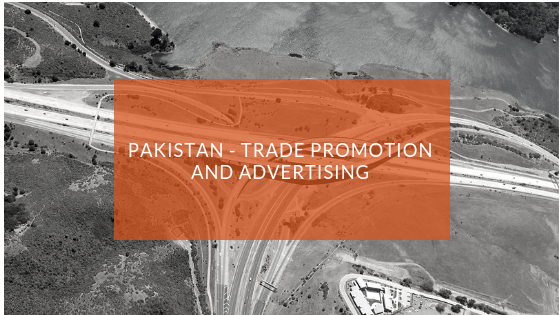Pakistan - Trade Promotion and Advertising
Includes web links to local trade fair or show authorities and local newspapers, trade publications, ratio/TV/Cable information.
 |
| Pakistan - Trade Promotion and Advertising |
Over a dozen major advertising agencies operate in Pakistan, some with foreign affiliation. Advertising agency commissions are usually 15 percent of the cost of the advertisement. By U.S. standards these agencies are fairly small concerns, with an annual billing of less than $20 million each.
Television and newspapers are the most widely used mode of advertising. Others include radio, billboards, periodicals and trade journals, direct response advertising, slides and commercial film shorts in movie theaters, short messages (SMS) through cellular phones, as well as internet-based social media.
Pakistan has over 402 daily newspapers and weekly, biweekly, and monthly magazines. The daily Jang, published in Urdu, is the largest newspaper with a claimed national circulation of almost 850,000. Combined circulation for the roughly 11 English-language newspapers is approximately 300,000. The principal English-language daily newspapers are Dawn (published in Karachi, Lahore and Islamabad), The News (Islamabad, Lahore and Karachi), The Nation (Lahore and Islamabad), Daily Times, Express Tribune and The Business Recorder (Karachi). Although the English-language press reaches only a small fraction of the population, it is influential in political, business, academic and professional circles.
The two major English-language current affairs magazines are monthlies - the Herald and Newsline. The principal English-language weekly economic magazine is the Pakistan and Gulf Economist, published in Karachi, and widely-read English weekly, The Friday Times, published from Lahore. Several special interest magazines such as Spider (Internet), Computerworld (Computer and IT) and Mobile Communications and Flare are steadily gaining prominence. Almost all newspapers in Pakistan are now available on the Internet.
Television is broadcast on state-owned Pakistan Television and several other local channels, using the PAL system. English language programs, including news, are available on several satellite channels.
Cable and Satellite Television: Cable television has been available in Pakistan for more than ten years and and channels continue to become more professional and organized. Broadcast media is regulated by the Pakistan Electronic Media Regulatory Authority (PEMRA), which has issued more than 800 licenses to prospective operators. It is estimated that cable television reaches approximately 30 percent of households in Pakistan. Regulatory details about broadcast media are available on the PEMRA website.
Satellite television broadcasts have made rapid inroads in Pakistan and it is estimated that more than 500,000 medium to high frequency dish antennas are presently installed in the country, although, with the advent of cable TV, the popularity of direct satellite television is gradually diminishing. More than 100 channels are received via satellite. The most popular transponder received in Pakistan is “Asiasat,” which carries most Indian TV channels.
Radio Pakistan reaches audiences within the country and abroad in 36 languages (19 regional and 17 foreign) from 24 medium and short wave stations and more than 15 FM stations. The FM license granted by the government does not permit them to broadcast exclusive news and current affairs programs.
Pakistan currently allows trade-advertising material other than commercial catalogs to enter duty-free, but levies a 15 percent sales tax on those items. Samples may be admitted duty free only if they are representative parts of a complete shipment or are unsuitable for sale. The duties applicable to commercial shipments apply to samples having a commercial value.
Trade Shows: The textile and apparel, leather and gemstones industries hold regular trade shows. Recently, the telecommunications, safety and security, higher education, information technology and oil and gas industries have become active in this area. Trade and seminar missions can also provide valuable first-hand insights into the Pakistani market, as well as serving to introduce U.S. equipment and technology. Trade missions can educate government and other end-users about product availability, technical characteristics, quality, and price, and can establish contacts with key organizations to promote product awareness. Presently, the trade show business in Pakistan is suffering tremendously from the security situation.






0 Comments